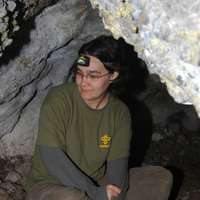Papers by Roumyana Angelova
Geologica Balcanica
The investigations are carried out with sandy, silty and clayey loess varieties from North Bulgar... more The investigations are carried out with sandy, silty and clayey loess varieties from North Bulgaria. The obtained results manifest a significant increase of the compressive strength of loess-cement mixtures in time (1.5—5.0 times) in comparison with the standard test period (1 month). This is a favourable factor for wide and various application of this material. The methods included in the group of surface mixing (soil-cement cushions; impervious screens and protective facings) are developed and widely used in Bulgaria. Unfortunately, the group for deep stabilization (deep mixing method; jet-grouting and soil-cement piles) is only occasionally applied in Bulgaria. Deep mixing stabilization is of great promise in treatment of high collapsible loess bases, saturated loess, loess areas with high seismic intensity and different environmental applications.

2-7 EFFECT OF SOME CHEMICAL ADDITIVES ON THE STRENGTH DEVELOPMENT OF SOIL-CEMENT ABSTRACT The use... more 2-7 EFFECT OF SOME CHEMICAL ADDITIVES ON THE STRENGTH DEVELOPMENT OF SOIL-CEMENT ABSTRACT The use of cement or lime for soil stabilization is widespread in Bulgaria; in foundation works on collapsing loess soils using a soil-cement cushion and in water irrigation by the construction of impermeable screens. One way of controlling the technological parameters and regulating the properties of the soil-cement is the addition of various chemical reagents but there are almost no data in the literature concerning the effect of chemical activators on the long-term strength of soil-cement. This paper describes the influence of the most common inorganic chemical additives (NaOH, CaO and CaCl2) on the strength kinetics and the fabric formation of loess-cement. The investigation was carried out over a period of two years and included unconfined compressive strength tests, X-ray diffraction and scanning electron microscopy as well as the determination of carbonate content, free CaO, pH and the c...
The geotechnical properties of soils spread over the area of town of Pomorie have been defined. A... more The geotechnical properties of soils spread over the area of town of Pomorie have been defined. An engineering geological map in a scale of 1:10 000 has been drawn up and four zones has been divided. The third and fourth zones are characterized with most complicated geotechnical conditions due to distribution of soft saturated soils and fine grained sands. Intense sea erosion, with rate of dilution of 1 m/a have been established. Seismic hazard exists because of historical information for strong earthquakes in the past and the presence of liable to liquefaction soils in the Pomorie area.
The geotechnical properties of soils (clays of the Brusarci Formation and loess complex) spread o... more The geotechnical properties of soils (clays of the Brusarci Formation and loess complex) spread over the area of Danube right bank between the town of Kozloduy and the village of Gorni Tsibar have been determined. Complex landslides and river erosion are the most important geodynamic processes in the study area. Engineering geological zoning has been carried out, with two separated zones. The second zone is characterized with most complicated geotechnical conditions due to distribution of both old landslides and recently landslide activation in some sub-zones.

The geotechnical properties of soils spread over the area of town of Pomorie have been defined. A... more The geotechnical properties of soils spread over the area of town of Pomorie have been defined. An engineering geological map in a scale of 1:10 000 has been drawn up and four zones has been divided. The third and fourth zones are characterized with most complicated geotechnical conditions due to distribution of soft saturated soils and fine grained sands. Intense sea erosion, with rate of dilution of 1 m/a have been established. Seismic hazard exists because of historical information for strong earthquakes in the past and the presence of liable to liquefaction soils in the Pomorie area. Резюме. Обобщени са резултатите за инженерногеоложките свойства на основните строителни почви в района на гр. Поморие. Извършено е инженерногеоложко райониране в М 1:10 000, като са отделени четири подрайона. С най-сложни инженерногеоложки условия се характеризират ІІІ и ІV подрайон, в които са разпространени тини, тинести пясъци и пясъци, отличаващи се с най-неблагоприятни геотехнически свойства. О...

1 Геологически институт, Българска академия на науките, ул. "Акад. Г. Бончев", бл. 24, ... more 1 Геологически институт, Българска академия на науките, ул. "Акад. Г. Бончев", бл. 24, 1113 София 2 Университет по архитектура, строителство и геодезия, бул. "Христо Смирненски" № 1, 1046 София Abstract. Aggregates produced from crushed rocks are widely used building material. In railway transport they are often applied in ballast construction. Ballast is a part of upper railway structure, which distributes the load from the railroad sleepers and facilitates surface water drainage. Rock aggregates from 11 railway ballast-producing quarries in Bulgaria have been investigated. The test materials consist of different in age igneous and sedimentary rocks: basaltic andesite, trachyte, andesitic tuff, diabase, quartz-cemented sandstone, dolomite and 5 varieties of limestone. The petrographic analysis of rocks has been performed and their texture, structure and mineral composition have been determined. The standard laboratory tests (Los Angeles and micro-Deval) and in s...

ABSTRACT Stabilization by hydraulic binders is a method extensively used in Bulgaria for the impr... more ABSTRACT Stabilization by hydraulic binders is a method extensively used in Bulgaria for the improvement of the properties of soils, which otherwise do not meet the requirements of modern construction. The first attempts of deep stabilization of fissured rocks by grouting were made in the 1940s. Cementation (by grouting or mixing on the surface) has begun to be applied since the 1950s and 1960s in the building of all large dams and related installations, in the construction of impervious screens of water basins, in the foundation of buildings in collapsible soils, in the construction of bases of roads and agricultural storages, etc. The varied applications of these methods of stabilization, as well as the results obtained of scientific investigations have been reflected in more than 100 scientific publications, several books and a great number of unpublished reports. It is the main purpose of this book to sum up the Bulgarian experience in cementation of rocks and soils and to present the recent scientific achievements in this field.

Abstract: Railway embankments in many regions in Bulgaria are often built of marly clays, since m... more Abstract: Railway embankments in many regions in Bulgaria are often built of marly clays, since more convenient soils are not available. These clays are characterized by high carbonate content, high silt content, and content many marl pieces. Because of these features, marly clays are difficult for processing and compacting and exhibit considerable deformability in consequence. Their use as a material for railway embankment construction in Bulgaria is a source of many operational problems. The intensified traffic during the recent years as well as the water filtration through the ballast bed decreases the bearing capacity of some railway sections. A technology for stabilization of railway embankments by lime columns and soil-lime cushion is proposed in the present paper. A saturated embankment in firm to soft consistency and with oedometer modulus Eoed in some zones up to 2 MPa is stabilized using the following technology. The top 3 m of the embankment are removed. A part of the dis...
The basic properties of loess in North Bulgaria and its advantages and disadvantages have been an... more The basic properties of loess in North Bulgaria and its advantages and disadvantages have been analyzed from the point of view of the site selection for a permanent surface-type repository intended for short-lived low (LLW) and intermediate-level (ILW) radioactive wastes from nuclear power generation.
lib.hpu.edu.cn
... 1, pp.515-518. Miller, H., Jefferson, IF, Djerbib, Y. and Smalley IJ (1999). "The co... more ... 1, pp.515-518. Miller, H., Jefferson, IF, Djerbib, Y. and Smalley IJ (1999). "The collapse of quaternary metastable loess." Quarterly Journal of Engineering Geology and Hydrogeology. (in press). Rollins, KM, Jorgensen, SJ and Ross, TE (1998). ...

Geologica Balcanica, 2017
Crushed-rock aggregates from 11 railway ballast-producing quarries in Bulgaria have been investig... more Crushed-rock aggregates from 11 railway ballast-producing quarries in Bulgaria have been investigated. The test materials consist of igneous and sedimentary rocks of different ages: basaltic andesite, trachyte, diabase, andesitic tuff, quartz-cemented sandstone, dolomite and five varieties of limestone. The standard laboratory tests (Los Angeles, micro-Deval and point load) and in-situ test (Schmidt hammer) were carried out for determination of the following mechanical properties of aggregates: resistance to fragmentation; wear resistance; strength; and rock hardness. Results show that Los Angeles coefficient (LA) values range from 11.9% to 28.4%. The micro-Deval coefficient (MDE) varies between 3.7% and 22.4%. The point load strength index (IS(50)) is between 4.0 MPa and 8.8 MPa. The Schmidt hammer rebound value (SHV) ranges from 34.4 to 60.2. The possibility of predicting the Los Angeles and micro-Deval coefficients from the Schmidt hammer rebound value and the point load strength...











Uploads
Papers by Roumyana Angelova